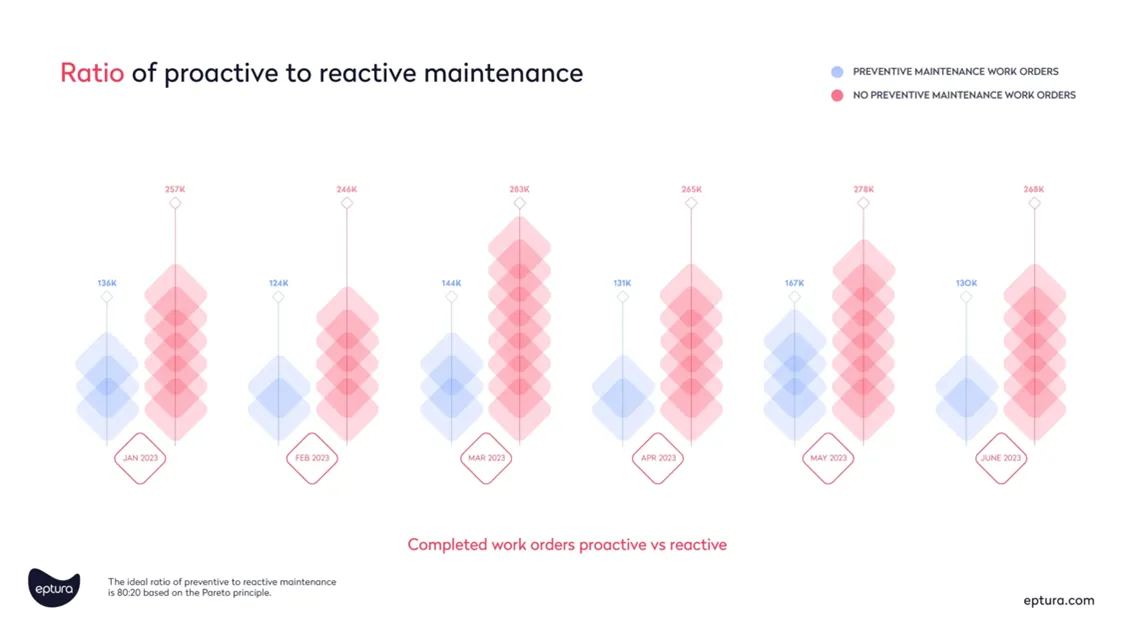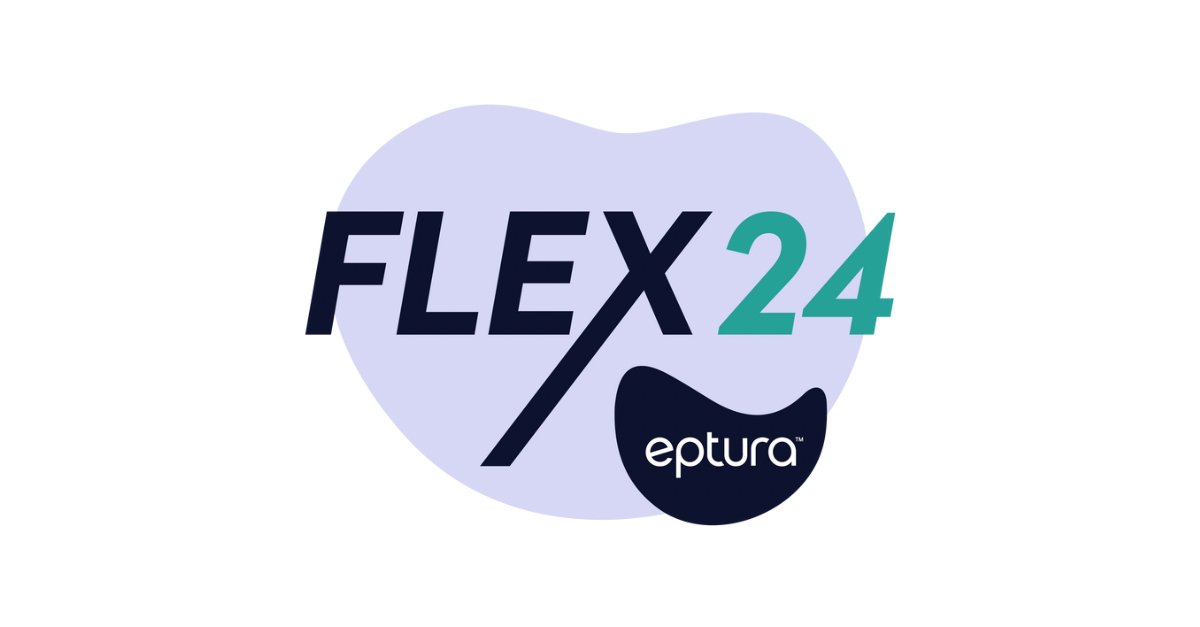
According to our latest quarterly survey, employees generally visit the office during the mid-week. This fact of today’s workplace has financial and management implications across teams using a range of different systems and processes.
What does the mid-week spike mean for your asset management, maintenance, and repair teams? Or your security and reception support for managing visitors? As more and more employees return to the office, how are they sharing space? What impact does that have on cleaning the facilities or on controlling building energy costs or managing inventory?
For maintenance teams today, workload ratios are working against them. The ideal ratio of preventive to corrective maintenance is roughly 4:1. But our Q2 data shows a ratio of 4:7. It means that for every four work orders planned, maintenance is responding to more than seven break-fix or other ad hoc ticket requests.

The problem isn’t data. There’s no shortage of it. It’s being able to make good decisions from it quickly and easily – and automate rote, highly repeatable processes from the information. It’s being able to manage it all across connected workflows. i.
Between 2020 and 2022, global enterprise data grew at a rate of 42% – a total of 2.02 petabytes, according to Statista. But it’s not the amount that’s surprising; it’s what people aren’t doing with the data. Just over a third (32%) of all that data is put to work. Nearly 70% of enterprise data goes unused, according to IDC research.
Data tends to sit and live across more systems and in more siloes than you may need, often takes too long to process, and can miss the mark in helping justify decisions in today’s rapidly changing world of work.
“Companies of all sizes have been forced to dedicate resources to five, 10, or even 15 different workplace and facility management tools,” explained Brandon Holden, CEO of Eptura, earlier this year. “With reduced budgets and fewer resources, organizations need to shift toward unified platforms that replace individual solutions.”
It’s time to rethink work models and modes
What’s needed is a complete rethink of working models. Gone are the days when business properties were assessed by measuring cost per square foot, cost per use, and customer satisfaction scores in isolation. With today’s range of flexibility, hybrid work patterns, employers need to know how to measure the necessary balance between experience and efficiency, and flexibility and certainty.
“We need to get away from this idea of the binary day in the office versus the day at home,” says Leonie M. Hicks, Workplace Strategy Consultant, Unispace on our Workplace Innovator podcast. “If we could incorporate some more flexibility around the hours worked, I think this would be a way to earn the commute.”
Our 16,000+ customers are experimenting with different work modes and models, and are increasingly adopting integrated technology that connects data and measures how employees use the physical space. More and more facility managers and employees are taking advantage of artificial intelligence, machine learning, and automation to help reconfigure offices and other types of workspaces while improving the maintenance of physical assets and building operations.
Worktech is the bridge.
Data helps unlock technology and process siloes to find more balance
Data helps companies right-size their floorplans and real estate portfolio using space planning software to match demand while simultaneously managing the costs of building operations. But one size doesn’t fit all.
Our recent global poll as reported in the Q2 Workplace Index reflects how fragmented businesses are today:
- 42%: Too much space
- 30%: Need more information to understand
- 28%: Not enough space
When data from facility management systems is integrated and harmonized with data from workplace systems, businesses can find the right balance between the function of a workplace and the operation of the building.
See all of our recent data. Get the Workplace Index report now.
Guidance
Make data the asset that helps you better manage your assets
The days of the real estate footprint being a static asset are in the past. Real estate, facility managers, and building operations professionals today are treating data as an asset. Business leaders need to streamline costs, so it’s not surprising that real estate is a major area for finding savings. But how do business leaders optimize their buildings and workspaces so they’re attractive to employees but less of a burden on the bottom line?
“This idea of improving the efficiency and accuracy of asset management processes and most importantly, decision making, will help everything become clearer so that you can actually make proper decisions,” says Paul Doherty, President and CEO, Digit Group on our Asset Champion podcast.
For facility managers today, being able to shift the balance of maintenance activities from unscheduled to scheduled, organizations can optimize work around building occupancy activity. The right data in the right unified system can help with better manage the full lifecycle of assets – and the get the most life from assets as possible.
Focus on what you need to know and your stakeholders
To assess their spaces in terms of the value they add and the financial efficiency they deliver, employers need multi-layered data points. When faced with opposing demands, what is often missing from the boardroom discussion is effective data to give a clear picture of the success of workplace utilization.
A deeper understanding of employee behavior across all workspaces makes planning for maintenance more straightforward and makes it easier to accommodate flexible working hours and workloads for everyone. For example, if meeting room data shows most meetings tend to end before 4 pm on mid-week in-office days because of flexible work scheduling, maintenance crews can begin planned work earlier. Precise data that shows these kinds of patterns can help. Unify workplace and asset processes and functions with advanced worktech
Mapping data from facilities management onto data from the workplace is powerful. By doing so, businesses will be better able to find the right balance between how the workplace functions and how the buildings need to operate.
With sensors, for example, organizations can get a better understanding of employee behavior. This helps facility managers measure load times in different parts of the workplace. By gaining a deeper understanding of employee behavior, not only does planning become more straightforward, but it becomes easier to accommodate more flexible working hours for everyone.
With digital twins, organizations can model scenarios and situations based on real world conditions using real time data to better manage budgets and better plan for costs that are likely to happen.
Companies can now find a whole range of blind spots — allowing managers to explore, locate, interact with, and report on it all. Within the context of smart buildings and digitally connected commercial real estate portfolios, digital twins help optimize space planning and maintenance decisions faster and better.
Facility and asset leaders need to work closely with front of house leaders to combine data analysis and decision making
By aligning facility management with the same floorplans and utilization data that the workplace and HR teams are accessing, organizations can proactively pause access to floors and redirect desk and room bookings to other spaces to accelerate maintenance projects.
This will help companies efficiently manage their assets and real estate portfolio to match demand, while simultaneously ensuring they create a cost-effective experience to attract people into the office.


